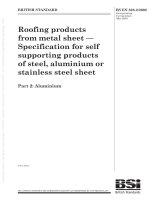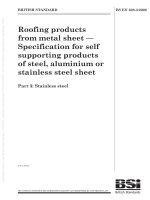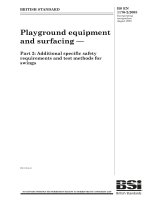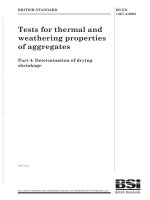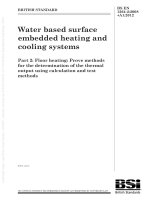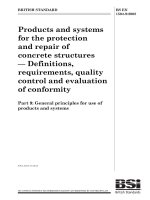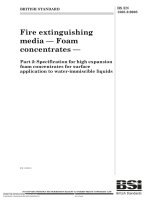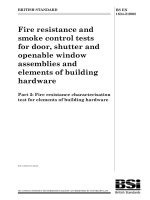Bsi bs en 01474 2 2008 (2009)
Bạn đang xem bản rút gọn của tài liệu. Xem và tải ngay bản đầy đủ của tài liệu tại đây (418.5 KB, 34 trang )
BRITISH STANDARD
Installation and
equipment for
liquefied natural gas
— Design and testing
of marine transfer
systems
Part 2: Design and testing of transfer
hoses
ICS 75.200
NO COPYING WITHOUT BSI PERMISSION EXCEPT AS PERMITTED BY COPYRIGHT LAW
BS EN
1474-2:2008
BS EN 1474-2:2008
National foreword
This British Standard is the UK implementation of EN 1474-2:2008.
The UK participation in its preparation was entrusted to Technical
Committee GSE/38, Installation and equipment for LNG.
A list of organizations represented on this committee can be obtained on
request to its secretary.
This publication does not purport to include all the necessary provisions
of a contract. Users are responsible for its correct application.
Compliance with a British Standard cannot confer immunity
from legal obligations.
This British Standard
was published under the
authority of the Standards
Policy and Strategy
Committee on 31 March
2009
Amendments/corrigenda issued since publication
Date
Comments
© BSI 2009
ISBN 978 0 580 57977 6
标准分享网 www.bzfxw.com 免费下载
BS EN 1474-2:2008
EUROPEAN STANDARD
EN 1474-2
NORME EUROPÉENNE
EUROPÄISCHE NORM
December 2008
ICS 75.200
English Version
Installation and equipment for liquefied natural gas - Design and
testing of marine transfer systems - Part 2: Design and testing of
transfer hoses
Installations et équipements de gaz naturel liquéfié Conception et essais des systèmes de transfert marins Partie 2: Conception et essais des tuyaux de transfert
Anlagen und Ausrüstung für Flüssigerdgas - Auslegung und
Prüfung von Schiffsübergabesystemen - Teil 2: Auslegung
und Prüfung von Übergabeschläuchen
This European Standard was approved by CEN on 1 November 2008.
CEN members are bound to comply with the CEN/CENELEC Internal Regulations which stipulate the conditions for giving this European
Standard the status of a national standard without any alteration. Up-to-date lists and bibliographical references concerning such national
standards may be obtained on application to the CEN Management Centre or to any CEN member.
This European Standard exists in three official versions (English, French, German). A version in any other language made by translation
under the responsibility of a CEN member into its own language and notified to the CEN Management Centre has the same status as the
official versions.
CEN members are the national standards bodies of Austria, Belgium, Bulgaria, Cyprus, Czech Republic, Denmark, Estonia, Finland,
France, Germany, Greece, Hungary, Iceland, Ireland, Italy, Latvia, Lithuania, Luxembourg, Malta, Netherlands, Norway, Poland, Portugal,
Romania, Slovakia, Slovenia, Spain, Sweden, Switzerland and United Kingdom.
EUROPEAN COMMITTEE FOR STANDARDIZATION
COMITÉ EUROPÉEN DE NORMALISATION
EUROPÄISCHES KOMITEE FÜR NORMUNG
Management Centre: rue de Stassart, 36
© 2008 CEN
All rights of exploitation in any form and by any means reserved
worldwide for CEN national Members.
B-1050 Brussels
Ref. No. EN 1474-2:2008: E
BS EN 1474-2:2008
EN 1474-2:2008 (E)
Contents
Page
Foreword..............................................................................................................................................................4
1
Scope ......................................................................................................................................................5
2
Normative references ............................................................................................................................5
3
Terms, definitions and abbreviations ..................................................................................................5
4
4.1
4.1.1
4.1.2
4.1.3
4.1.4
4.1.5
4.1.6
4.2
4.2.1
4.2.2
4.2.3
Description of typical LNG transfer hose designs and accessories................................................6
A LNG transfer hose system shall consist of the following..............................................................6
A flexible hose assembly, comprising.................................................................................................6
Connection system to LNGC ................................................................................................................6
Emergency release system...................................................................................................................6
Handling..................................................................................................................................................7
Power systems.......................................................................................................................................7
Leak detection, monitoring and alarm systems .................................................................................7
Typical construction of LNG transfer hoses.......................................................................................7
Main hose categories ............................................................................................................................7
Corrugated metal hoses........................................................................................................................7
Composite hoses ...................................................................................................................................9
5
5.1
5.2
5.3
5.4
5.5
5.6
5.7
5.8
5.9
5.9.1
5.9.2
5.9.3
5.9.4
5.10
5.11
5.12
5.13
Design features of the LNG transfer hoses and transfer hoses assemblies.................................10
General..................................................................................................................................................10
Application data required ...................................................................................................................10
Selection of hose length .....................................................................................................................10
Service life ............................................................................................................................................11
Selection of hose size .........................................................................................................................11
Selection of buoyancy.........................................................................................................................11
Selection of insulation ........................................................................................................................11
Basic design parameters ....................................................................................................................11
Component details – End fitting.........................................................................................................11
General..................................................................................................................................................11
Termination ..........................................................................................................................................12
Connector .............................................................................................................................................13
Bending stiffener/restrictor (optional) ...............................................................................................13
Hose handling / lifting device .............................................................................................................13
Safety systems.....................................................................................................................................13
Connection to the ship ........................................................................................................................14
Hydraulic and electric control systems.............................................................................................14
6
6.1
6.2
6.3
6.4
6.4.1
6.4.2
6.4.3
6.5
Inspection and tests ............................................................................................................................14
Foreword...............................................................................................................................................14
Laboratory testing ...............................................................................................................................15
Prototype hose testing ........................................................................................................................15
Factory acceptance tests....................................................................................................................18
General..................................................................................................................................................18
All hoses ...............................................................................................................................................18
FAT tests on one hose per order .......................................................................................................18
System testing .....................................................................................................................................18
7
7.1
7.2
7.3
7.4
7.5
Quality assurance and control ...........................................................................................................18
General..................................................................................................................................................18
Material selection.................................................................................................................................18
Marking .................................................................................................................................................19
Manufacturing ......................................................................................................................................19
Documentation related to an approved certification process: .......................................................19
2
标准分享网 www.bzfxw.com 免费下载
BS EN 1474-2:2008
EN 1474-2:2008 (E)
8
8.1
8.2
8.3
Documentation.....................................................................................................................................19
For information a purchasing guidelines table is given in Annex A..............................................19
As-built documentation.......................................................................................................................19
Operation manual ................................................................................................................................20
Annex A (informative) Purchasing guidelines table ......................................................................................21
Annex B (normative) Prototype and factory acceptance tests for LNG hose assemblies........................27
Annex C (informative) Surge pressure considerations for LNG hoses .......................................................29
Bibliography ......................................................................................................................................................31
3
BS EN 1474-2:2008
EN 1474-2:2008 (E)
Foreword
This document (EN 1474-2:2008) has been prepared by Technical Committee CEN/TC 282 “Installation and
equipment for LNG”, the secretariat of which is held by AFNOR.
This European Standard shall be given the status of a national standard, either by publication of an identical text or
by endorsement, at the latest by June 2009, and conflicting national standards shall be withdrawn at the latest by
June 2009.
Attention is drawn to the possibility that some of the elements of this document may be the subject of patent rights.
CEN [and/or CENELEC] shall not be held responsible for identifying any or all such patent rights.
This European Standard consists of 3 parts:
EN 1474-1: Installation and equipment for liquefied natural gas — Design and testing of marine transfer
systems — Part 1: Design and testing of transfer arms
EN 1474-2: Installation and equipment for liquefied natural gas — Design and testing of marine transfer
systems — Part 2: Design and testing of transfer hoses
EN 1474-3, Installation and equipment for liquefied natural gas — Design and testing of marine transfer
systems — Part 3: Offshore transfer systems
According to the CEN/CENELEC Internal Regulations, the national standards organizations of the following
countries are bound to implement this European Standard: Austria, Belgium, Bulgaria, Cyprus, Czech Republic,
Denmark, Estonia, Finland, France, Germany, Greece, Hungary, Iceland, Ireland, Italy, Latvia, Lithuania,
Luxembourg, Malta, Netherlands, Norway, Poland, Portugal, Romania, Slovakia, Slovenia, Spain, Sweden,
Switzerland and United Kingdom.
4
标准分享网 www.bzfxw.com 免费下载
BS EN 1474-2:2008
EN 1474-2:2008 (E)
1
Scope
This European Standard gives general guidelines for the design, material selection, qualification, certification, and
testing details for Liquefied Natural Gas (LNG) transfer hoses for offshore transfer or on coastal weather-exposed
facilities for aerial, floating and submerged configurations or a combination of these. Whilst this European Standard
is applicable to all LNG hoses, it is acknowledged that there may be further specific requirements for floating and
submerged hoses.
The transfer hoses will be designed to be part of transfer systems (it means that they will be fitted with ERS,
QCDC, handling systems, hydraulic and electric components etc.) To avoid unnecessary repetition, crossreferences to EN 1474-1 and EN 1474-3, are made for all compatible items, and for references, definitions and
abbreviations. Where additional references, definitions and abbreviations are required specifically for LNG hoses,
they are listed in this European Standard.
Transfer hoses need to be durable when operating in the marine environment and to be flexible with a minimum
bending radius compatible with handling and the operating requirements of the transfer system.
2
Normative references
The following referenced documents are indispensable for the application of this document. For dated references,
only the edition cited applies. For undated references, the latest edition of the referenced document (including any
amendments) applies.
EN 1474-1:2008, Installation and equipment for liquefied natural gas — Design and testing of marine transfer
systems — Part 1: Design and testing of transfer arms
EN 1474-3:2008, Installation and equipment for liquefied natural gas — Design and testing of marine transfer
systems — Part 3: Offshore transfer systems
EN ISO 1746, Rubber or plastic hoses and tubings — Bending tests (ISO 1746:1998, including technical
corrigendum 1:1999)
EN ISO 7369, Pipework — Metal hoses and hoses assemblies — Vocabulary (ISO 7369:2004)
EN ISO 8330, Rubber and plastic hoses and hoses assemblies — Vocabulary (ISO 8330:2007)
EN ISO 9000, Quality management systems — Fundamentals and vocabulary (ISO 9000:2005)
EN ISO 9001, Quality management system — Requirements (ISO 9001:2000)
3
Terms, definitions and abbreviations
For the purposes of this document, the terms and definitions given in EN ISO 7369 and EN ISO 8330 apply.
NOTE 1
Exception to the above: for this document, the bending radii are measured from the centre line.
NOTE 2
For the purpose of this document hose assembly means the hose complete with end fittings, hose handling and
lifting devices (pad eyes, collars, …), as described in 4.1.1.
NOTE 3
For the purpose of this document, [MAWP] is defined in Clause 6 and Annex C.
NOTE 4
For the purpose of this document, [D] and [ND] are defined in Clause 6.
5
BS EN 1474-2:2008
EN 1474-2:2008 (E)
3.1
owner (or designated agent)
company or group of companies for whose use the hose assembly as defined in 4.1.1 is provided
3.2
vendor
company selling the hose assembly to the owner, and in charge of completing the hose assembly as defined in
4.1.1
4
Description of typical LNG transfer hose designs and accessories
4.1
A LNG transfer hose assembly shall consist of the following
4.1.1
A flexible hose assembly, comprising
flexible hose, refer to 4.2;
associated end terminations and connectors;
permanent identification marks;
hose handling device(s) (padeye or lifting lugs, lifting collar, …),
and if required:
leak detection system;
insulation system (to minimize build up of external ice);
intermediate leak barrier(s);
bending stiffeners or restrictors;
buoyancy.
4.1.2
Connection system to LNGC
Hose extremity connector flanges shall permit the mounting of a QCDC or a spool piece or permit direct
connection to LNGC or LNG terminal or another hose assembly.
(A description of QCDC is given in EN 1474-1, for transfer system reference is made to EN 1474-3).
Hubs, or other connectors if equivalent or superior to flanges, may be used if agreed between owner and
vendor.
4.1.3
Emergency release system
Hose extremity connector shall permit the mounting of an emergency release system with valves and ERC
(Emergency Release Coupler).
(A description of emergency release system is given in EN 1474-1 and EN 1474-3).
6
标准分享网 www.bzfxw.com 免费下载
BS EN 1474-2:2008
EN 1474-2:2008 (E)
4.1.4
Handling
Hose shall include necessary fittings for safe handling, coupling and uncoupling either from the LNGC or the
onshore or offshore LNG terminal system as required by the system design (refer to EN 1474-3).
4.1.5
Power systems
Hose may support (e.g. piggy back mounted) hydraulic or pneumatic hoses, electric cables for the powering of
the ERS and QCDC systems (refer to EN 1474-1:2008, Clause 6).
4.1.6
Leak detection, monitoring and alarm systems
If required by the owner the hose shall incorporate leak detection system e.g. gaseous nitrogen bleeding in the
annular space (see 5.11).
4.2
Typical construction of LNG transfer hoses
4.2.1
Main hose categories
At present LNG transfer hoses are categorized in two types according to their method of construction:
those based on a reinforced corrugated metal hose construction, hereafter called corrugated metal hose;
those based on a construction in which polymeric films and fabrics are entrapped between a pair of close
wound helical wires, hereafter called composite hose;
as the technology develops, other types of hose may become available and are also to be considered covered
by this European Standard.
4.2.2
4.2.2.1
Corrugated metal hoses
Hose
Inner layer
The inner layer is made of stainless steel corrugations (sometimes called bellows). This ensures the inner leakproofness of the structure, as well as sustaining the inner radial pressure.
Armour layers (if required)
These armour layers support the axial loading whilst providing an initial thermal insulation.
Spiral layer (if required)
This layer ensures that the armours remain in place, as well as providing some thermal insulation.
Thermal insulation layers
This layer (or series of layers) ensures that the inner temperature is conserved whilst preventing any build-up of ice
on the exterior of the hose.
Intermediate and outer leak-proof layers
The intermediate sheath gives the hose a double annulus, thus permitting the detection of any leak of LNG as soon
as it may occur. The external sheath prevents any ingress of water from the exterior.
7
BS EN 1474-2:2008
EN 1474-2:2008 (E)
The hose assembly construction shall ensure that all materials are used within their individual range of
temperature.
Key
1
leakproof layer
2
3
insulation
leakproof layer
4
5
insulation
supporting layer
6
7
armouring
leakproof layer
8
corrugated inner pipe
Figure 1 — Typical hose assembly – reinforced corrugated metal hose family
Depending on the design, the outer leak proof layer can be a corrugated stainless steel pipe similar to the inner
pipe. In this case the annular gap between inner and outer pipe may be evacuated. The pressure supervision of
this annular gap results in a leak detection of inner and outer pipe. The thermal insulation may be maintained by
layers of super insulation inside the evacuated annular gap.
8
标准分享网 www.bzfxw.com 免费下载
BS EN 1474-2:2008
EN 1474-2:2008 (E)
Key
1
pumping port
2
3
armouring
corrugated outer pipe
4
5
corrugated inner pipe
super insulation vacuum
6
vacuum supervision leak detection
Figure 2 — Typical hose assembly – Sketch of a LNG flexible hose with vacuum insulation option
4.2.2.2
End fitting assembly
The end fitting assembly is made of stainless steel, and ensures 2 primary functions.
The flexible termination incorporates the different layers of the flexible and ensures the integrity of each layer at its
end. The construction is designed to allow the immediate detection of any LNG leak into the inner annulus.
The end connector is connected to the associated piping at each end of the flexible. This will typically be a standard
ANSI flange.
4.2.3
Composite hoses
A composite hose consists of un-bonded, multiple polymeric film and fabric layers trapped between two wire
helices which give the hose its shape, one being internal and one being external. Broadly, the film layers provide a
fluid-tight barrier to the conveyed product and the fabric layers provide the mechanical strength of the hose.
In sequence, starting from the bore, the construction is as follows:
a) inner metallic wire helix applied at a pre-determined close pitch;
b)
polymeric fabric layers forming the bore material;
c)
pack of many polymeric film layers. The complete film pack achieves a tubular form and provides the fluid tight
barrier to the conveyed product;
9
BS EN 1474-2:2008
EN 1474-2:2008 (E)
d)
pack of many polymeric fabric layers which reinforce the hose;
e)
outer metallic wire helix applied at half a pitch offset to the inner wire under tension. This forms the hose into
the required convoluted structure.
The number and arrangement of the layers in steps c) and d) is specific to the hose size and application. The
polymeric film and fabric materials are selected to be compatible with the conveyed product and the extremes of
operating temperature.
Key
1
2
inner wire
film
3
4
fabric
outer wire
Figure 3 — Typical hose – composite hose family
5
5.1
Design features of the LNG transfer hoses and transfer hoses assemblies
General
The hose forms part of an overall system for the transfer of LNG – for the requirements which will dictate the exact
design of the hose (e.g. static load and dynamic movements, …) refer to EN 1474-3. The design process and
required information is outlined below.
5.2
Application data required
The application data required should be determined by the owner and/or the system vendor according to the
guidelines given in Annex A.
5.3
Selection of hose length
The overall hose length will be dictated by the system design and shall be sufficient to meet both storage and
operational conditions including motion envelopes as defined in EN 1474-3 (see also Annex A).
Depending on the length, system design and type, and other factors such as shipping requirements, the hose shall
be either supplied as a continuous length or as a string of discrete sections.
The hose length used in the system shall be such that the motion envelopes as defined in EN 1474-3 are met (see
also Annex A).
10
标准分享网 www.bzfxw.com 免费下载
BS EN 1474-2:2008
EN 1474-2:2008 (E)
Hose length shall take into account the elongation of the hose under pressure and its own weight. This elongation
shall be consistent with the transfer system design.
5.4
Service life
The required service life shall be agreed between the owner and the vendor.
The calculation of the hose service life will take into account the cumulative effects of the number and amplitude of
flexure, tensile, pressure and temperature cycles in operation, environmental ageing and the consequences of
emergency disconnections and internal pressure surge in service.
The safety ratio between service life, fatigue life and fatigue test duration shall be agreed by the owner and the
vendor and shall be documented.
5.5
Selection of hose size
The owner shall specify flow rate, maximum allowable working pressure, temperature, composition of product and
the maximum allowable head loss. The number of hoses to be used shall be either predefined by the system or can
be tailored to suit size limits and flow rate requirements.
The vendor shall confirm the Maximum Allowable Working Pressure (MAWP) of the hose assembly to allow the
owner to size pressure relief devices etc.
5.6
Selection of buoyancy
The transfer system shall be such that the hose is either floating, aerial, or the owner will specify the degree of
buoyancy if it is required (this will also include submersion requirements).
If buoyancy is required, it shall be agreed between the owner and the vendor.
5.7
Selection of insulation
If required the hose shall have sufficient insulation to minimize build-up of ice on the exterior of the hose itself and
to limit heat leak.
5.8
Basic design parameters
The MBP (Minimum Burst Pressure) ratio to the MAWP is given in Clause 6.
The FAT (Factory Acceptance Test) pressure is given in Clause 6.
The maximum flow velocity in the hose shall be agreed by the owner and the vendor.
Maximum allowable applied twist shall be specified by the vendor.
The hose shall be designed ensuring the compatibility of each component (layer) of the hose with its function (e.g.
LNG and NG service and testing values).
5.9
Component details – End fitting
5.9.1
General
The end fittings of any hose comprise of two main parts:
termination;
11
BS EN 1474-2:2008
EN 1474-2:2008 (E)
connector.
Illustration of an end fitting (typical, may vary depending on the hose design):
Key
1
handling collar
2
3
identification collar
bending stiffener (optional)
4
5
connector
termination
6
7
end fitting
hose
Figure 4 — Typical end fitting assembly – composite hose family
5.9.2
Termination
The termination shall ensure the following functions:
mechanical attachment of all component layers of the hose which resist against internal pressure, traction and
torsion;
provide a leak-proof seal against the transported fluid and/or gas;
provide a leak-proof seal against ingress of humidity or water from the outer environment.
The end fitting shall comply with the system fatigue criteria.
In the case of a burst test for proof purposes, the end fittings shall not separate from the hose.
12
标准分享网 www.bzfxw.com 免费下载
BS EN 1474-2:2008
EN 1474-2:2008 (E)
5.9.3
Connector
The connector shall either be machined into the end termination or welded to it in accordance with a qualified
procedure. The type of connector shall be specified by the owner and / or the system requirements.
5.9.4
Bending stiffener/restrictor (optional)
This is an optional item, either embedded into or mounted onto the hose at either one or both terminations, when
required. It has the function of providing a smooth transition of bending forces, if existing, from the end fitting to the
hose structure, and provides extra resistance to over bending.
The inclusion of a bend stiffener is at the vendors discretion following review of the operational conditions.
5.10 Hose handling / lifting device
Additional items such as the hose handling device (pad eyes or collar etc.), QCDC and ERS shall be designed as
part of the particular system and in accordance with EN 1474-1 and EN 1474-3. Specific hose handling instructions
shall be issued as part of the system.
Appropriate hose handling instructions shall be supplied with each order to allow correct handling during transport
and at others times prior to inclusion in the system.
A hose handling/lifting device shall be designed and proof tested to allow for safe handling of the complete hose.
When requested and upon mutual agreement between the vendor and owner, it can be designed to handle other
equipment which could be attached to either end of the hose.
Appropriate arrangements are to be provided to securely keep the hoses in stored position when not in service or
whilst being transported.
5.11 Safety systems
Leak detection (optional):
Hoses with annulus:
Gas detection if fitted is to be provided as a warning of leakage of the hose allowing appropriate action to be taken.
The system shall conform to one of the following:
leak detection of only the inner pipe. In case of a break of the inner pipe, the supervision system gives alarm
signal to the terminal, but NG escapes to the environment;
leak detection only at the end fitting to provide detection of seal failure;
leak detection of only the inner pipe. In case of a break of the inner pipe, the supervision system gives alarm
signal to the terminal. For small leaks the escaping gas is exhausted from the annular gap. The annular gap is
not able to withstand the MAWP of the hose;
leak detection of the inner pipe and an outer pipe if it is provided. In case of a leak in the outer pipe, the
supervision gives a certain alarm to the terminal. In case of a leak in the inner pipe, the supervision gives
alarm to the terminal and the escaping gas is covered by the outer pipe. The outer pipe is able to withstand
MAWP of hose.
Hoses without annulus:
Not all hoses have an annulus running along their entire length. In these cases a leak detection may be provided in
the vicinity of the transition.
13
BS EN 1474-2:2008
EN 1474-2:2008 (E)
Fire safety requirements:
Fire safety requirements, if specified shall be mutually agreed between owner and vendor, see also
EN 1474-3:2008, 7.6.
Electrical safety requirements:
Electrical continuity requirements shall be mutually agreed between the owner and the vendor, see also EN 14743:2008, 7.6.
5.12 Connection to the ship
Connection to the ship by the manifold will be achieved by handling the LNG hose assemblies by the means of
their dedicated connection on the hose system, see also EN 1474-3:2008, Clause 8.
5.13 Hydraulic and electric control systems
Any requirements for hydraulic and electric control system affecting the hose shall be specified by the owner (refer
to EN 1474-1:2008, Clause 7).
6
6.1
Inspection and tests
General
All qualification test results shall be recorded in a written report that shall be presented by the vendor to the owner.
This clause lists the minimum tests to be performed but is not aimed to give full description of the tests procedures,
which may vary between hose manufacturers and hose technologies.
As a general principle, all parameters / characteristics shall be verified by testing.
Annex B (normative) "Prototype and factory acceptance tests for LNG hose assemblies" gives a summary of the
tests to be performed.
In Clause 6 the following definitions apply:
Non-destructive [ND] – a test that is not expected to cause permanent damage to the hose assembly, so that the
hose may be used in subsequent tests.
Destructive [D] – a test that will cause permanent damage to the hose and/or one requiring the hose to be
dissected for examination purposes and the effect of that test on the hose structure and/or end termination integrity
to be assessed.
Maximum Allowable Working Pressure [MAWP] – The maximum pressure (gauge) across the entire specified
temperature range to which the hose may be exposed and operated. It is commonly used by terminals to define
their cargo system pressure capabilities (i.e. pump shut-in plus any static head or cargo system safety valve relief
setting. This pressure rating is not expected to account for dynamic surge pressures, but does include nominal
pressure variations during cargo transfer operations). In accordance with the IMO IGC Code “supplement to Edition
1993 chapter 5.7.3” (complete reference is given in Bibliography) the specified MAWP shall not be less than 10 bar
gauge. Reference is made to Annex C for surge pressure considerations.
Proof Pressure [PP] – The pressure to which the hose is tested (i.e. during a Factory Acceptance Test) to
demonstrate its structural integrity when subject to internal pressure. In accordance with the IMO IGC Code
(complete reference is given in Bibliography) this pressure test at ambient temperature shall be not less than
1,5 × MAWP and not more than two-fifths of its bursting pressure.
14
标准分享网 www.bzfxw.com 免费下载
BS EN 1474-2:2008
EN 1474-2:2008 (E)
Minimum Burst Pressure [MBP] – The minimum internal pressure at which the hose with sealed end caps shall
rupture. This shall be not less than 5,0 × MAWP (as defined above) at the extreme service temperature.
NOTE
6.2
This is in accordance with the IMO IGC Code (complete reference is given in Bibliography).
Laboratory testing
All test procedures and their parameters shall be in accordance with the vendor’s written test procedures.
1)
Ambient mechanical properties of all materials – ascertain that the mechanical properties of the materials
are suitable for their intended application and within specification limits;
2)
Cryogenic mechanical properties of all materials which have to work at cryogenic temperature (these may
be supplemented with supplier data) – ascertain that the mechanical properties of the materials are
suitable for their intended application at cryogenic temperatures;
3)
Effect of LNG exposure on all materials which have to work at cryogenic temperature – ascertain that the
mechanical properties of the materials are not detrimentally affected (or quantify the effect within
acceptable and defined limits) by exposure to LNG/NG;
4)
Effect of ambient climatic exposure on all materials (exposed to atmosphere) – ascertain that the effects of
such exposure do not adversely affect the performance of the materials over the hose design life;
NOTE
This test could be combined with test 5.
5)
6.3
Effect of marine environment (e.g. corrosion of metallic components) on all exposed layers (exposed to
the marine environment) – ascertain that the effects of the marine environment do not adversely affect the
performance of the materials over the hose design life.
Prototype hose testing
All test procedures and their parameters shall be in accordance with the vendor written test procedures.
1)
Ambient pressure and leak test [ND] (this shall be the first test to be carried out) – demonstrate that the
unrestrained hose assembly with end caps is capable of supporting its proof pressure without leaking at
ambient temperature.
Hydrostatic test at ambient temperature shall be held for 4 h after stabilization. Both temperature and
pressure values to be recorded; any pressure variation directly attributable to temperature variation is
acceptable. Temporary and permanent elongation shall be recorded.
2)
Cryogenic pressure and leak test [ND] – demonstrate that the unrestrained hose assembly with end caps
is capable of supporting its proof pressure without leaking at extreme (lowest) service temperature;
temporary and permanent elongation shall be recorded.
Liquefied nitrogen test held for 4 h. A leak detection monitoring device shall be used.
3)
Stiffness characterization tests (both ambient and cryogenic) [ND].
a) Axial stiffness (may be conducted as part of tests 9 and 14) – to quantify the axial stiffness of the hose at
both ambient and extreme (lowest) service temperatures.
15
BS EN 1474-2:2008
EN 1474-2:2008 (E)
b) Bend stiffness (may be conducted as part of tests 10 and 15) to quantify the bend stiffness and verify the
minimum bend radii (storage and working) of the hose at both ambient and extreme (lowest) service
temperatures.
NOTE 1 Bending radius is measured to the hose centre line.
c) Torsional stiffness (may be conducted as part of tests 11 and 16) to quantify the torsional stiffness of the
hose at both ambient and extreme (lowest) service temperatures.
4)
Pressure cycle test [ND) at ambient temperature to demonstrate that the unrestrained hose assembly with
end caps is capable of withstanding 200 pressure cycle test from zero to at least twice the specified
MAWP.
NOTE 2 This is in accordance with IMO IGC Code (complete reference is given in Bibliography).
5)
Burst test [D] at ambient temperature (may be combined with test 1) – ensure that the minimum burst
pressure is at least 5 times the MAWP.
The hydrostatic burst test on the unrestrained hose assembly with end caps shall be carried out with a
steady pressure increase to rupture. A leak detection monitoring shall be used.
6)
Cryogenic burst test (may be combined with test 2) [D] – the minimum burst pressure is at least 5 times
the MAWP.
The cryogenic burst test on the unrestrained hose assembly with end caps shall be carried out with a
steady pressure increase to rupture, using liquefied nitrogen.
7)
Ambient impact testing [D] – to quantify an impact load that the hose is capable of withstanding.
8)
Ambient crush testing [D] – to quantify a crush load that the hose is capable of withstanding.
9)
Ambient tensile test to MWL (Maximum Working Load) [ND] – confirm that the hose is capable of
supporting its maximum working load whilst at MAWP.
Hose shall be gradually loaded to MWL and pressurized hydrostatically to MAWP. Hose shall be
examined for leaks whilst being held for 15 min at MWL and MAWP. Temporary and permanent
elongation shall be recorded. No damage should be evident.
10) Ambient bend test to MBR (Minimum Bend Radius) [ND] – confirm that the hose is capable of supporting
its MAWP at working MBR (radius for hose is measured to centre line); based on the principles given in
EN ISO 1746.
Hose should be gradually bent to the MBR and then pressurized to MAWP and hose examined for leaks
whilst being held for 15 min at MBR. No damage should be evident on return to pre-test conditions.
In case the hose is not manufactured in a single length continuous hose, the connection between hose
and coupling shall be tested under load conditions. The test arrangement shall include a hose coupling
(preferably at mid-point) within the hose length. Testing should induce the Minimum Bend Radius to occur
in the hose section adjacent to the flange.
11) Ambient twist to MAAT (Maximum Allowable Applied Twist) [ND] – confirm that the hose is capable of
supporting its maximum working load whilst at MAAT.
The hose shall be pressurized hydraulically to MAWP. The twist angle shall be increased to MAAT and
hose examined for leaks whilst being held for 15 min at MAAT. No damage should be externally evident.
12) Cryogenic impact testing [ND] – To ensure that the specified ambient impact load that the hose is capable
of withstanding without damage is still applicable at the minimum service temperature.
16
标准分享网 www.bzfxw.com 免费下载
BS EN 1474-2:2008
EN 1474-2:2008 (E)
13) Cryogenic crush testing [ND] – To ensure that the specified ambient crush load that the hose is capable of
withstanding without damage is still applicable at the minimum service temperature.
14) Cryogenic tensile test to MWL [ND] – confirm that the hose is capable of supporting its specified working
load whilst at MAWP.
The hose pressurized with liquefied nitrogen to MAWP. The axial load increased to MWL (pressure may
be reset to account for expansion) and hose examined for leaks whilst being held for 15 min at MWL. No
damage should be externally evident. Temporary and permanent elongation shall be recorded.
15) Cryogenic bend test to MBR [ND] – confirm that the hose is capable of supporting its specified working
load whilst at working MBR.
The hose shall be gradually bent to the MBR cooled down and pressurized with liquefied nitrogen to
MAWP. The hose shall be examined for leaks whilst being held for 15 min at MBR. No damage should be
evident on return to ambient pre-test conditions i.e. ovality check and no residual deformation.
16) Cryogenic twist to MAAT [ND] – confirm that the hose is capable of supporting its specified working load
whilst at MAAT.
The twist angle shall be increased to MAAT The hose shall be pressurized with liquefied nitrogen to
MAWP, and examined for leaks whilst being held for 15 min at MAAT. No damage shall be evident.
17) Ambient to MAWP / ambient to minimum temperature cycle test [ND/D] - To demonstrate that the hose
assembly is capable of withstanding temperature/pressure cycles. A minimum of 20 combined test cycles
of pressure/ temperature shall be carried out.
18) Cryogenic bending cyclic fatigue testing [ND/D] to demonstrate the fatigue resistance of the hose to
bending cycles. A minimum of 400 000 cycles shall be carried out.
Tests 17 and 18 above could be combined into one test.
In case the hose is not manufactured in a single length continuous hose, the connection between hose
and coupling shall be tested under load conditions. The test arrangement shall include a hose coupling
(preferably at mid-point) within the hose length. Testing should induce the Minimum Bend Radius to occur
in the hose section adjacent to the flange.
19) Wear testing (owner/system specific) [D] – demonstrate the wear resistance of the outer most layer of the
hose.
20) Flow rate testing (ambient or cryogenic) [ND] – demonstrate that the hose is capable of operating at its
maximum flow rate and confirm the predicted head loss.
Test may be carried out at maximum flow rate. Any damage to inner layers or excessive vibrations shall
be recorded, as well as the test configuration.
This will be re-assessed once specific configuration has been determined.
21) Submersion (hydrostatic pressure - submarine hoses only) [ND] - demonstrate that the hose is capable of
supporting the hydrostatic head of seawater at its maximum rated depth.
Submerge the empty and blinded hose to its maximum rated depth and hold for 24 h. The hose shall not
collapse or be otherwise damaged.
22) Buoyancy (floating hose only) [ND] - to demonstrate that the buoyancy of the hose or hose assembly is
adequate for a floating application.
23) Insulation testing [ND] - verify that the hose thermal insulation performance is as specified.
17
BS EN 1474-2:2008
EN 1474-2:2008 (E)
24) Electrical testing [ND] - confirm that the hose is either electrically continuous or discontinuous and that the
resistance value is appropriate for the designation.
Hose shall be drained and supported above ground by non-conductive means and the resistance
measured between the two end fittings (connection face). Electrically continuous hoses shall have a
resistance of less than 10 Ω. Electrically discontinuous hoses shall have a resistance of not less than
25 000 Ω.
6.4
Factory acceptance tests
6.4.1
General
All listed tests are non-destructive. The results of these tests shall be recorded in a written report.
6.4.2
All hoses
1)
Ambient pressure leak test including approved drying procedure.
Measurements to include pressure, ambient temperature and humidity. Temporary and permanent
elongation checks).
2)
Electrical testing (for electrical continuity).
3)
Dimensional checks (length, diameter (OD and ID) connectors etc.).
4)
Cleanliness check.
5)
Inspection of marking and identification plate (marking requirements defined elsewhere).
6.4.3
FAT tests on one hose per order
To be mutually discussed and agreed between owner and vendor.
6.5
System testing
Tests to confirm the hose performance as part of the overall system shall be conducted by the system vendor (may
or may not be the hose vendor). The requirements for these tests are defined in EN 1474-3.
7
7.1
Quality assurance and control
General
The quality system shall conform to EN ISO 9000 and EN ISO 9001. Validation of all design and testing by a
competent certifying authority by full review and/or type approval shall be carried out.
7.2
Material selection
The material selection of all materials and associated equipment for cryogenic hoses shall be defined, with
validation by a competent certifying authority, on material specification data sheets. These data sheets shall fully
describe each component layer, its function, the approved suppliers and quality control levels.
The material specification data sheet shall also include auxiliary materials e.g. nuts, bolts, seals, welding materials.
18
标准分享网 www.bzfxw.com 免费下载
